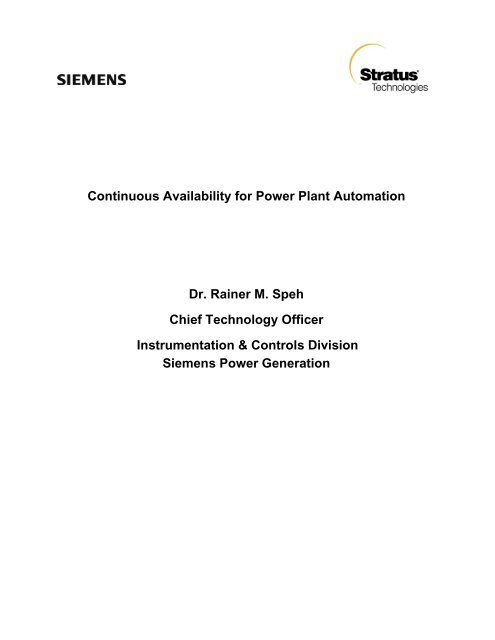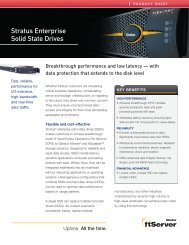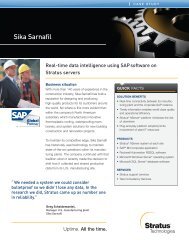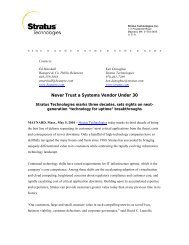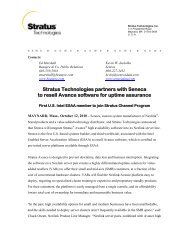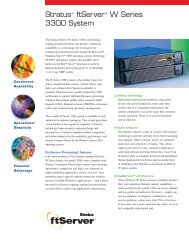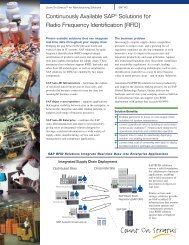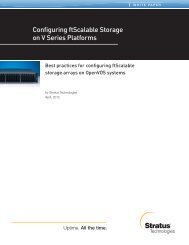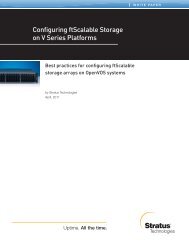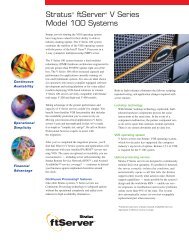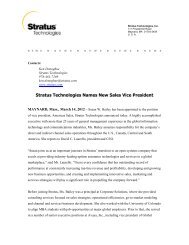Read Siemens Power Plant Automation whitepaper (PDF)
Read Siemens Power Plant Automation whitepaper (PDF)
Read Siemens Power Plant Automation whitepaper (PDF)
You also want an ePaper? Increase the reach of your titles
YUMPU automatically turns print PDFs into web optimized ePapers that Google loves.
Continuous Availability for <strong>Power</strong> <strong>Plant</strong> <strong>Automation</strong><br />
Dr. Rainer M. Speh<br />
Chief Technology Officer<br />
Instrumentation & Controls Division<br />
<strong>Siemens</strong> <strong>Power</strong> Generation
1 Introduction<br />
If you ask power producers just what their key requirements are for instrumentation and control<br />
systems in power plants and for enterprise management, you will nearly always get the same<br />
answer. The right information at the right time and the right place is what they expect, and that<br />
for minimum investment and maintenance costs.<br />
For private use we would seem to have found the answer: the Internet. But in the past few years<br />
this has also started to be used in the automation sector in general and especially in the field of<br />
power plant controls. Almost all I&C suppliers now offer expansions to existing systems to enable<br />
remote use of at least part of the locally available functions. The communication structures used<br />
here are identical with those of the Internet.<br />
To achieve compatibility for the various different functionalities, the existing software systems are<br />
provided with an additional, outer layer. In this context we talk of wrapping. To date there has not<br />
yet been any new development of an I&C system that reflects the basic architecture of the<br />
Internet, the so-called three tier architecture, right from the design stage. The benefits of an<br />
architecture of this kind are obvious. On the one hand, this matches the mainstream of the IT<br />
world and thereby enables seamless integration of enterprise-wide communication. This is an<br />
absolute must for information provision in liberalized energy markets. On the other hand, this<br />
also yields additional benefits for system maintenance and management in terms of low total<br />
cost of ownership.<br />
<strong>Siemens</strong> <strong>Power</strong> Generation is proud to present SPPA-T3000, the first web-based power plant<br />
I&C system in the world that is truly worthy of this name.<br />
2
2 Generations of Control Systems<br />
In the late 1960s, computers made their debut in power plants. The first application was<br />
a sequence-of-event recorder based on a main frame computer in a nuclear power<br />
plant.<br />
The next generation of computing in power plants was introduced at the end of the<br />
1980s, using local networks that enabled a client/server architecture. This is still the<br />
structure in use in most control systems current today.<br />
With the introduction of the Internet, not only in daily life but also in the business<br />
environment, the third generation of control systems was developed as an extension of<br />
the client/server architecture mentioned above. The resulting system structure would<br />
come to be known in the industry as “web-enabled”. But it is also a fact that this third<br />
generation of control systems is still made up of a number of different subsystems. This<br />
will ultimately lead to increased maintenance costs in the long run.<br />
The latest trend in general automation as well as in power plant controls is a system<br />
structure called “web-based”, also known as the fourth generation of control systems.<br />
The cornerstone here is the basic architecture of the Internet with its three tiers: the<br />
presentation, the processing, and the data tier. This configuration is reflected as early as<br />
the system design phase and not added by wrapping existing software as is done for<br />
web-enabled systems. Figure 1 shows the development of the different generations<br />
over the course of the last fifty years.<br />
3
Mainframes<br />
1960<br />
1970<br />
Client / Server<br />
1980<br />
1990<br />
Figure 1 Generations of Control Systems<br />
Web enabled<br />
1999<br />
Three Tier<br />
Web based<br />
It can essentially be stated that the I&C structures described here for the third and fourth<br />
generations support the trend toward increasing centralization. This applies not only for technical<br />
facilities, but also for organizational structures. A good fifteen years ago, distributed<br />
configurations were all the rage, and now the current trend is more and more back to centralized<br />
structures. One of the reasons for this is surely the enhanced information acquisition and<br />
provision capabilities that are now available. Modern communication networks such as corporate<br />
and public networks provide a real low-cost, reliable platform. Any information, anytime and<br />
anywhere at nearly no cost is not longer a vision, it’s reality.<br />
In liberalized energy markets an additional factor that is becoming increasingly significant in<br />
addition to the standard considerations of high reliability and a long lifetime for I&C systems is<br />
not merely the input of the maximum amount of data but far rather the input of the right<br />
information and thereby the important information into the decision-making process in good time<br />
and at the right point. This demands not just knowledge of the technical background, but<br />
application-specific know-how and process expertise to separate the important from the<br />
unimportant and enable a meaningful customer-specific solution to be offered. <strong>Siemens</strong> as a<br />
provider offers the unique combination of being one of the leading power plant equipment<br />
suppliers and at the same time the market leader in the power plant I&C sector. It is thus hardly a<br />
coincidence that this innovative step into the fourth generation was taken by <strong>Siemens</strong>.<br />
4<br />
2005
3 System Overview<br />
3.1 System Structure<br />
SPPA-T3000, the latest power plant I&C system from <strong>Siemens</strong> <strong>Power</strong> Generation, is the first<br />
fourth-generation automation system worldwide. Based on experiences gained in over 250 plants<br />
which have been equipped with the web-enabling extension web4txp [1] since 1999, a system<br />
has been completely designed according to three-tier architecture. Figure 2 shows the principle<br />
of the SPPA-T3000 system structure and illustrates how the different tiers are mapped onto a<br />
control system.<br />
Presentation<br />
Tier Tier<br />
Processing<br />
Tier<br />
Data<br />
Tier<br />
Figure 2 SPPA-T3000 system structure<br />
Thin Clients<br />
Application <strong>Automation</strong><br />
Server Server Server<br />
(Stratus ftServer) (Simatic S7 400 series)<br />
I/O I/O Modules<br />
The uppermost tier is composed of thin clients. In addition to the recommended and tested<br />
devices for the control room, these can be terminal devices of any kind, such as notebooks,<br />
desktop computers or personal digital assistants (PDAs). The only precondition, besides the<br />
communication capabilities via TCP/IP and an operating system, is a browser which supports<br />
Java applets. No further software installations are necessary for use as an operator terminal,<br />
engineering workplace or diagnostics client. Everything the user needs on his/her front-end<br />
5
device is uploaded when the central application server is started. This means that no specific<br />
maintenance or update work is required for these applications.<br />
The use of thin clients also makes possible seamless integration in the existing infrastructure of<br />
an enterprise and the use of existing systems without any additional costs. This means that no<br />
specific hardware or software is required for the human-machine interface outside the control<br />
room.<br />
Two different types of servers constitute the middle tier, also known as the processing tier. The<br />
application server is a fault-tolerant server from Stratus Technologies [2]. It is based on a two-<br />
processor design (SMR) and is fully redundant. Its availability is >99.999%. One application<br />
server is required for each plant or machine (unit).<br />
One or more automation servers are used depending on the size of the power plant and the task<br />
to be implemented. These are based on proven hardware from the market leader in automation<br />
engineering, i.e. from the Simatic S7 400 series. This ensures system reliability and longevity of<br />
investment.<br />
The fault-tolerant network which has been tested and utilized over the years takes the form of<br />
open rings and is based on Industrial Ethernet [3]. It is used as a communication network<br />
between thin clients and application servers on the one hand and to automation servers on the<br />
other. Transmission speeds up to 1 GB/s can be realized in line with the currently accepted<br />
standard. Optical or wire-based media are used depending on the switches selected for<br />
implementation.<br />
All I/O modules are assigned to the data tier. Components from the Simatic range which have<br />
been proven over the years are also used here. I/O modules which contain a processing function<br />
are also available. These feature an intrinsic capability for operation under emergency<br />
conditions. The connection of an auto/manual station is a simple operation if required. Special<br />
modules for turbine I&C with processing functions for short cycle times even shorter than 5 ms,<br />
e.g. for position controllers, complete the I/O spectrum.<br />
6
All I/O modules are connected to the automation servers via a redundantly configured Profibus<br />
[4], which can be operated at up to 12 MB/s. Both copper wire and fiber-optic cables can be used<br />
as a transmission medium.<br />
3.2 Software Architecture<br />
The software architecture of SPPA-T3000 is illustrated in Figure 3. It conforms to the system<br />
structure shown in Figure 2. The user interfaces are assigned to the presentation tier, the power<br />
services to the processing tier, and the process interfaces to the data tier.<br />
User<br />
Interfaces<br />
<strong>Power</strong><br />
Services<br />
Process<br />
Interfaces<br />
Application Server<br />
RT Cont.<br />
Diag.<br />
Session<br />
Web Browser<br />
Eng.<br />
Persist.<br />
<strong>Plant</strong> Display<br />
Servlet<br />
Operat.<br />
Alarm<br />
Archive<br />
Project Cont.<br />
<strong>Plant</strong> Disp.<br />
Eng. Editor<br />
Alarm List<br />
Diagnostic<br />
…<br />
Engineering<br />
Servlet<br />
Session<br />
Managemnt.<br />
Archive<br />
Figure 3 SPPA-T3000 software architecture<br />
Diag.<br />
I&C IN<br />
Execut.<br />
Eng.<br />
Report<br />
Generator<br />
Operat.<br />
Alarm<br />
I&C<br />
OUT<br />
RT Container<br />
(on board)<br />
Alarm<br />
Managemnt.<br />
<strong>Automation</strong><br />
Server<br />
…<br />
Diag.<br />
I&C IN<br />
Execut.<br />
RT Container<br />
(realtime)<br />
I/O<br />
I/O<br />
I/O<br />
Modules I/O<br />
I/O<br />
Modules<br />
As already explained in the previous section, standard PCs and PDAs can be utilized for the user<br />
interface in the presentation tier as well as the recommended thin clients. The use of different<br />
operating systems and browsers is also possible in theory. However, due to the high distribution<br />
7<br />
Eng.<br />
Operat.<br />
Alarm<br />
I&C<br />
OUT
level of Windows, the use of the most recent version of the software and of Internet Explorer as a<br />
browser is recommended, as this configuration has been tested intensively and released.<br />
The real advantage of the thin client lies in its universality, which permits all functions, such as<br />
operation, engineering and diagnostics, to be performed on one machine. This standard work<br />
environment is referred to as a Workbench and makes an individual work environment possible<br />
on each front-end device.<br />
The majority of the power services are processed on the application server. The design of the<br />
Stratus fault-tolerant server provides a single-system image to both the operating system<br />
(Windows Server 2003) and the applications. This allows for load-and-go simplicity. Applications<br />
achieve unprecedented availability without the need for any modification. Any standard Windows<br />
or Linux application, from integration servers to spreadsheets, can take advantage of this<br />
platform. Applications and subsystems that require high-availability can now utilize a common<br />
approach in the plant. A common approach to availability will reduce both risk and maintenance<br />
costs across your application portfolio –reducing your TCO.<br />
The project container constitutes the core of the application server. All the configuration data,<br />
current parameters and status information are stored centrally in a hierarchical file structure in<br />
the form of XML files. Unlike previous systems, the management of redundant data is not<br />
necessary. This design also ensures system-intrinsic data consistency. In theory it also very<br />
easy to make these data available to downstream processing programs independently of the<br />
system, e.g. in the office environment, using additional middleware.<br />
OPC interfaces in server and client versions are also available for the exchange of I&C<br />
information. Other interfaces for the connection of black box applications, e.g. for ash handling,<br />
are provided via additional communication modules and are connected to the network parallel to<br />
the automation servers. Like all other system components, these can also be configured<br />
redundantly.<br />
8
The actual web server, the servlets for the representation of plant displays and the various<br />
engineering functions are also components of the application server. These include session and<br />
user management, the report generator and alarm management. All the applications of the<br />
application server are programmed in Java and are therefore by definition independent of the<br />
hardware and the operating system. This ensures investment security for both the user and the<br />
supplier in the fast-moving world of information technology.<br />
The on-board runtime container is a special feature of the application server. This allows<br />
applications to be generated and tested during plant operation with the help of an easily created<br />
simulation environment without any effect on operation. When testing has been completed<br />
successfully, the new functions can then be loaded in the real-time runtime containers of the<br />
automation servers and executed.<br />
It must be noted here that the load procedure of the automation servers has been drastically<br />
shortened thanks to the modern software architecture. If we take an application comprising 1000<br />
function blocks and 8000 links as an example, it takes a mere 15 seconds for the necessary data<br />
to be loaded into a runtime container, where they can be executed immediately. This procedure<br />
can take minutes or even hours in conventional systems.<br />
Overall it can be said that a very robust design has been achieved through the selected software<br />
architecture. Both the runtime containers and the function blocks, which are known as<br />
automation function instances (AFI) in SPPA-T3000, are software objects which outwardly<br />
exhibit the same basic structure. The containers represent the runtime environment in which the<br />
AFIs can be executed with little or no interaction. Advantages resulting from this structure include<br />
online expansion and modification capabilities. Operating experience with the first plants<br />
implemented in this design has been more than impressive and provides convincing arguments<br />
for this approach.<br />
9
4 User Benefits<br />
4.1 Enterprise-wide Information<br />
Increased centralization in organizations and in technology has been one of the megatrends of<br />
the past five years. Driven by enterprise-wide internal networks and the Internet as a global<br />
communication medium, the right information can be supplied to the decision processes in good<br />
time. Technical preconditions include efficient information processing and the thin clients<br />
described above as a front end.<br />
SPPA-T3000 supports this megatrend in a unique way. Thanks to the selected software<br />
architecture and the very powerful user management, different users can be allowed individual<br />
views of the information and the possible action radius of each individual user can be accurately<br />
defined. In addition to the assignment of roles to individual persons, access rights can also be<br />
set up according to process engineering areas. Data inconsistencies become a thing of the past<br />
because only one instance of each item of information is stored in the system. The resulting data<br />
consistency advantages are also apparent in the reduced engineering work load.<br />
The use of open communication standards in the area of wireless communication also opens up<br />
further options. Mobile terminal devices make all information available locally, not only for the<br />
purposes of commissioning but also during operation and troubleshooting. If a suitable<br />
infrastructure is planned, a mobile operator even becomes possible.<br />
Interface to applications in the power plant itself, such as to a computerized maintenance<br />
management system (CMMS), and on the enterprise control level to enterprise resource<br />
planning systems (ERP) can be implemented at any time using SPPA-T3000. The system thus<br />
constitutes the foundation stone for the success of the company by providing the right<br />
information at the right time and in the right place.<br />
10
4.2 Total Cost of Ownership<br />
Modern I&C is characterized by the use of accepted industry standards. The advantages offered<br />
by this are obvious (e.g. standardized spare parts management and no necessity for special<br />
maintenance skills). Continual performance improvements in the IT world are an additional<br />
bonus.<br />
The unique software architecture of SPPA-T3000 offers other significant benefits. The<br />
subsystems of present-day I&C systems are completely replaced by a transparent, lean system<br />
structure. The maintenance required for different platforms with different operating systems and<br />
different life cycles finally becomes a thing of the past. The maintenance tasks which are no<br />
longer necessary thanks to the use of thin clients have already been mentioned above.<br />
The hardware architecture of SPPA-T3000 has also been designed using industry standards<br />
including I/O modules and automation servers from <strong>Siemens</strong> –the leader in automation. For the<br />
Application Server the best-of-breed Stratus ftServer was selected for its proven reliability,<br />
operational simplicity, and widespread industrial market acceptance.<br />
Together the functionality and architecture of the SPPA-T3000 system delivers operational<br />
results at the lowest cost.<br />
4.2 Easy to Use<br />
An outstanding feature of SPPA-T3000 is that the system itself is so easy to use. During<br />
operation, any relevant item of information is only ever a mouse click away. The faceplate<br />
navigation bar shown in Figure 4a contains buttons which enable you to go directly to the<br />
various views of the same object. This makes it possible, for example, to jump directly from the<br />
plant display to the function diagram and to the correct place within the diagram. It is important to<br />
mention that the faceplate always remains open and visible for operation. This creates an ideal<br />
work environment for commissioning and troubleshooting.<br />
11
a) Navigation from Faceplates<br />
Select options<br />
Open IC-Diagram<br />
Open Force AF Block<br />
Open Diagnostic View<br />
Open Trend Display<br />
Open Point View<br />
Open Help<br />
Figure 4 SPPA-T3000 faceplates<br />
b) Examples of Faceplates<br />
Motor<br />
(US Version)<br />
Motor<br />
(European Version)<br />
The high level of adaptability of the work environment is a further highlight of SPPA-T3000. As<br />
well as being able to display several languages in parallel for different users, colors, time and<br />
date formats and other display characteristics can also be defined for the entire project. Various<br />
libraries are also available for different faceplates and icons. Figure 4b shows the same<br />
faceplate in the US and European styles as an example.<br />
12
5 Conclusion<br />
SPPA-T3000, the first fourth-generation I&C system worldwide, was developed especially for the<br />
comprehensive automation of all types of power plant. Its modern web-based architecture allows<br />
it to be integrated seamlessly into the existing infrastructure of power generation companies and<br />
constitutes the perfect basis for enterprise-wide information distribution. The use of off-the-shelf<br />
components ensures that the total cost of ownership remains low. Its high degree of flexibility<br />
permits simple adaptations for projects and also for the individual user. Simplicity of operation,<br />
engineering and diagnostics is an outstanding feature. More than thirty orders within the first nine<br />
months following its sales release and extremely positive customer feedback from the first plants<br />
confirm this. Not only for this reason has SPPA-T3000 already become known as the new<br />
benchmark in controls.<br />
Links<br />
[1] http://www.powergeneration.siemens.com/en/processcontrol/index.cfm<br />
[2] Stratus Technologies engineers and manufactures an ultra-reliable line of fault<br />
tolerant-servers that provide continuous application availability. Stratus ® servers offer full<br />
fault-tolerant protection to Windows ® and Linux ® -based applications. Stratus has been in<br />
business for over 25 years supporting critical Fortune 500 customer applications around<br />
the world. www.stratus.com<br />
[3] http://www.automation.siemens.com/net/html_76/produkte/040_produkte.htm<br />
[4] http://www.profibus.com/<br />
All trademarks and registered trademarks are the property of their respective holders.<br />
© 2006 <strong>Siemens</strong> AG. All rights reserved.<br />
13


